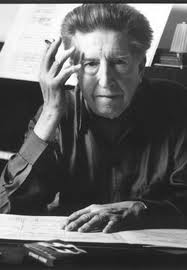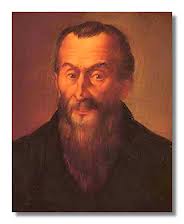January 20, 2014.Dutilleux and Willaert.A year ago, when we celebrated Henri Dutilleux’s 96th birthday, he was living in Paris and still working.He died five months later, on May 22nd, leaving behind a major body of work, and already a classic.Dutilleux was born on January 22nd, 1916 in Anger in western France.He studied at the Paris Conservatory, graduating in 1938.After the War, he worked for many years at Radio France as the head of music production and left only in 1963 to dedicate himself to composing.In 1961 Alfred Cortot, the founder of École Normale de Musique de Paris, invited him to join the school.After Cortot’s death Dutilleux for a while served as the school’s president.Dutilleux assigned the first opus to his Piano Sonata, which he wrote for his wife, the pianist Geneviève Joy, in 1946-48, even though by then he had already been composing for at least 10 years.Even though he disavowed his earlier composition, his Sonatine for flute and piano (1943) is performed quite often.
Although Dutilleux’s style was affected by Debussy and Ravel, he was a modernist who used atonality and complex rhythms.He was also a perfectionist, revising his compositions over and over.Here is Dutilleux’s sonorous Timbres, espace, movement (Timbre, space, movement), a 1978 composition for an unusual combination of instruments: woodwinds, brass, cellos, percussions, but no violins or violas.Timbres was commissioned by Mstislav Rostropovich, who gave the premier with the National Orchestra the same year.The piece carries a subtitle, “The Starry Night,” after the painting by Van Gogh.The Bordeaux Aquitaine National Orchestra is conducted by Hans Graf.And for someone who likes more austere music, here is his String quartet, Ainsi la nuit (“So the night”), which Dutilleux composed in 1976-76.It’s performed by the Belcea Quartet.
Adrian Willaert had an interesting life: a talented Franco-Flemish composer, he followed in the steps of Josquin des Prez, and then later established the Venetian musical school.Willaert was born in a small Flemish town of Rumbeke around 1490 (the same time as John Taverner, about whom we wrote last week).We know about his life from the writings of his student, the composer and music theorist Gioseffo Zarlino.Willaert went to Paris to study law but switched to music instead.One of his teachers was Jean Mouton, the composer of the Royal chapel.Around 1515 Willaert moved to Rome.Later, he entered the service of Cardinal Ippolito d'Este of Ferrara (it’s interesting that some years earlier Josquin was employed by Ippolito’s father, Ercole I d'Este, Duke of Ferrara).In 1527 Willaert received an exceptional appointment in Venice, becoming the maestro di cappella of the St. Mark cathedral.He held that post till his death in 1562.During that time he composed a large number of masses, motets, madrigals and other secular music.He also had many students, among them Andrea Gabrieli. Venetian music owes much to the architecture of St. Mark.The cathedral is unusual in that it has not one but two choir lofts, on each side of the main alter, with organs in both lofts.Willaert used this spatial separation to divide the choir in two and wrote “antiphonal” music, in which the melody is sung alternatively by both choirs.The Gabrielis, Andrea and Giovanni, made good use of it, and eventually this technique became known as Venetian polichoral style.
We’ll hear a beautiful madrigal by Willaert, O dolce vita mia, performed by the King’s Singers.And here is his motet Pater Noster as performed by another British ensemble, Magdala, directed by the founder, David Skinner.
Dutilleux and Willaert 2014
January 20, 2014. Dutilleux and Willaert. A year ago, when we celebrated Henri Dutilleux’s 96th birthday, he was living in Paris and still working. He died five months later, on May 22nd, leaving behind a major body of work, and already a classic. Dutilleux was born on January 22nd, 1916 in Anger in western France. He studied at the Paris Conservatory, graduating in 1938. After the War, he worked for many years at Radio France as the head of music production and left only in 1963 to dedicate himself to composing. In 1961 Alfred Cortot, the founder of École Normale de Musique de Paris, invited him to join the school. After Cortot’s death Dutilleux for a while served as the school’s president. Dutilleux assigned the first opus to his Piano Sonata, which he wrote for his wife, the pianist Geneviève Joy, in 1946-48, even though by then he had already been composing for at least 10 years. Even though he disavowed his earlier composition, his Sonatine for flute and piano (1943) is performed quite often.
head of music production and left only in 1963 to dedicate himself to composing. In 1961 Alfred Cortot, the founder of École Normale de Musique de Paris, invited him to join the school. After Cortot’s death Dutilleux for a while served as the school’s president. Dutilleux assigned the first opus to his Piano Sonata, which he wrote for his wife, the pianist Geneviève Joy, in 1946-48, even though by then he had already been composing for at least 10 years. Even though he disavowed his earlier composition, his Sonatine for flute and piano (1943) is performed quite often.
Although Dutilleux’s style was affected by Debussy and Ravel, he was a modernist who used atonality and complex rhythms. He was also a perfectionist, revising his compositions over and over. Here is Dutilleux’s sonorous Timbres, espace, movement (Timbre, space, movement), a 1978 composition for an unusual combination of instruments: woodwinds, brass, cellos, percussions, but no violins or violas. Timbres was commissioned by Mstislav Rostropovich, who gave the premier with the National Orchestra the same year. The piece carries a subtitle, “The Starry Night,” after the painting by Van Gogh. The Bordeaux Aquitaine National Orchestra is conducted by Hans Graf. And for someone who likes more austere music, here is his String quartet, Ainsi la nuit (“So the night”), which Dutilleux composed in 1976-76. It’s performed by the Belcea Quartet.
Adrian Willaert had an interesting life: a talented Franco-Flemish composer, he followed in the steps of Josquin des Prez, and then later established the Venetian musical school. Willaert was born in a small Flemish town of Rumbeke around 1490 (the same time as John Taverner, about whom we wrote last week). We know about his life from the writings of his student, the composer and music theorist Gioseffo Zarlino. Willaert went to Paris to study law but switched to music instead. One of his teachers was Jean Mouton, the composer of the Royal chapel. Around 1515 Willaert moved to Rome. Later, he entered the service of Cardinal Ippolito d'Este of Ferrara (it’s interesting that some years earlier Josquin was employed by Ippolito’s father, Ercole I d'Este, Duke of Ferrara). In 1527 Willaert received an exceptional appointment in Venice, becoming the maestro di cappella of the St. Mark cathedral. He held that post till his death in 1562. During that time he composed a large number of masses, motets, madrigals and other secular music. He also had many students, among them Andrea Gabrieli. Venetian music owes much to the architecture of St. Mark. The cathedral is unusual in that it has not one but two choir lofts, on each side of the main alter, with organs in both lofts. Willaert used this spatial separation to divide the choir in two and wrote “antiphonal” music, in which the melody is sung alternatively by both choirs. The Gabrielis, Andrea and Giovanni, made good use of it, and eventually this technique became known as Venetian polichoral style.
chapel. Around 1515 Willaert moved to Rome. Later, he entered the service of Cardinal Ippolito d'Este of Ferrara (it’s interesting that some years earlier Josquin was employed by Ippolito’s father, Ercole I d'Este, Duke of Ferrara). In 1527 Willaert received an exceptional appointment in Venice, becoming the maestro di cappella of the St. Mark cathedral. He held that post till his death in 1562. During that time he composed a large number of masses, motets, madrigals and other secular music. He also had many students, among them Andrea Gabrieli. Venetian music owes much to the architecture of St. Mark. The cathedral is unusual in that it has not one but two choir lofts, on each side of the main alter, with organs in both lofts. Willaert used this spatial separation to divide the choir in two and wrote “antiphonal” music, in which the melody is sung alternatively by both choirs. The Gabrielis, Andrea and Giovanni, made good use of it, and eventually this technique became known as Venetian polichoral style.
We’ll hear a beautiful madrigal by Willaert, O dolce vita mia, performed by the King’s Singers. And here is his motet Pater Noster as performed by another British ensemble, Magdala, directed by the founder, David Skinner.